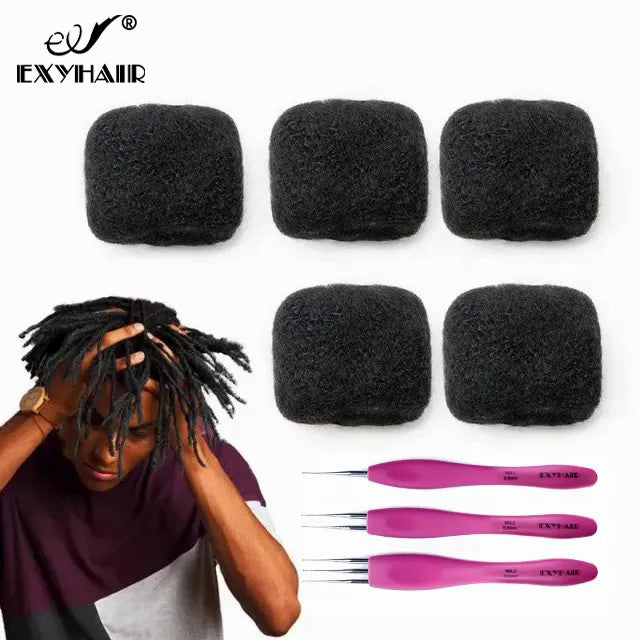Top Reasons Why Your Loc Extensions Are Unraveling — and How to Fix Them

Loc extensions have become one of the most popular hairstyles for those seeking versatility, low-maintenance styling, and a natural look. Whether you are new to locs or a seasoned wearer, unraveling loc extensions is a frustrating issue that can disrupt your style and confidence. Understanding the root causes of unraveling and learning how to properly care for your locs is crucial for maintaining their longevity and appearance.
In this comprehensive guide, we’ll dive deep into the reasons your loc extensions might be unraveling, provide practical solutions, and share preventative strategies to keep your locs looking flawless.
1. Using the Wrong Hair Type
The type of hair used in loc extensions plays a pivotal role in their durability. Not all hair textures are suitable for locs.
Why It Causes Unraveling:
Hair that is too silky or smooth tends to slip, making it difficult for locs to interlock naturally.
Synthetic hair with low tensile strength may shed or tangle improperly.
Low-quality human hair may not withstand regular manipulation.
Why Afro Kinky Bulk Hair Works Best:
Textured and coarse, mimicking natural hair
Locks and interlocks easily
Holds styles such as twists, braids, and interlocking longer without unraveling
Fix & Preventive Measures:
Always choose high-quality Afro kinky bulk hair.
Avoid mixing different textures unless you are experienced with blending hair types.
Test a small section before full installation if you’re unsure about the hair texture.
2. Improper Installation Techniques
Even the best hair can unravel if installed incorrectly. The technique used—whether interlocking, braiding, or crochet—affects the longevity of your locs.
Common Installation Mistakes:
Locs installed too loosely
Skipping the interlocking step
Using inappropriate tools for the hair type
Uneven sectioning or tension
How to Fix:
Consult a professional stylist trained in loc extensions.
If DIY-ing:
Start with clean, detangled hair
Use a crochet hook or interlocking tool suitable for your loc thickness
Ensure even sections and consistent tension
For already unraveling locs: gently tighten loose sections using interlocking tools or crochet methods.
Pro Tip: For beginners, it’s easier to practice on small sections before attempting full head installation.
3. Overwashing and Harsh Products
Keeping your loc extensions clean is essential, but overwashing or using the wrong products can cause damage.
Why Overwashing Causes Unraveling:
Repeated washing loosens the hair bonds
Harsh shampoos strip natural oils, causing dryness and brittleness
Heavy gels or waxes build up and prevent proper locking
Recommended Practices:
Wash every 1–2 weeks using a gentle, residue-free shampoo
Focus on scalp cleansing rather than scrubbing the locs themselves
Use light moisturizing sprays instead of heavy oils or waxes
DIY Tip: Mix a few drops of essential oil (like tea tree or lavender) with water in a spray bottle for a light, refreshing mist.
4. Sleeping Without Proper Protection
Nighttime friction is a silent enemy of loc extensions. Cotton pillowcases, in particular, can create friction that loosens locs and frizzes the hair.
Fix & Prevent:
Wrap locs with a silk or satin scarf before sleeping
Use a silk or satin pillowcase as an extra protective layer
Avoid tight hairstyles overnight; loose or low-tension styles reduce stress on locs
Extra Tip: If your locs are long, consider twisting them loosely into a bun or braid before bed.
5. Excessive Manipulation
Daily styling, re-twisting, or pulling on locs may damage the hair bonds and cause unraveling. This is especially common with loc extensions that have added length or volume.
How to Reduce Damage:
Limit re-twisting to every 4–6 weeks
Avoid styles that pull tightly on the roots
When styling, gently separate strands instead of forcefully detangling
DIY Repair: If locs are starting to loosen, use a crochet hook to tighten the affected sections rather than cutting or removing them.
6. Humidity and Environmental Factors
Weather plays a significant role in loc maintenance. High humidity, rain, and sweat can cause frizz and loosening.
Fix:
Apply a light holding gel or mousse to maintain twist integrity
Protect locs with hats or scarves during humid or rainy conditions
After exposure to moisture, gently re-twist or tighten the affected sections
Pro Tip: Keep a small spray bottle with water and a light styling gel for on-the-go touch-ups.
7. Neglecting Regular Maintenance
Loc extensions require consistent upkeep. Without maintenance, new hair growth can loosen locs, and frizz can accumulate, making the locs appear unraveled.
Maintenance Routine:
Retwist or interlock every 4–6 weeks
Cleanse scalp regularly but sparingly
Trim stray hairs to maintain a neat appearance
Apply lightweight moisturizer to prevent dryness and breakage
Pro Tip: Keeping a maintenance calendar can help you stay on top of retwisting and washing schedules.
8. Low-Quality Loc Extensions
Sometimes, the problem isn’t your care routine—it’s the quality of the extensions themselves. Low-grade locs may shed, frizz excessively, or fail to hold twists.
How to Identify Quality Hair:
100% human hair, preferably Afro kinky bulk
Consistent texture and thickness
Minimal shedding
Vendor reputation and customer reviews
Fix & Preventive Measures:
Always invest in high-quality loc extensions
Avoid extremely cheap synthetic hair that doesn’t interlock well
Step-by-Step Guide to Repairing Unraveled Locs
If your loc extensions are unraveling, follow these steps to restore them:
Assess Damage: Identify which locs are loose or frizzy.
Retwist or Interlock: Use a crochet hook or interlocking tool to tighten the locs.
Trim Frizz: Carefully snip stray hairs without cutting too much.
Apply Gel or Mousse: A lightweight product helps hold the twist.
Deep Condition Occasionally: Maintains hair strength and reduces breakage.
Reinstall If Needed: For severely damaged locs, you may need to redo sections.
Pro Tip: Work in sections to avoid overwhelming yourself and ensure even results.
Tools and Products Recommended for Loc Extensions
Crochet Hooks & Interlocking Tools: Essential for DIY repair and maintenance
Lightweight Moisturizing Sprays: Keep hair hydrated without loosening twists
Residue-Free Shampoos: Prevent buildup and frizz
Silk or Satin Scarves & Pillowcases: Reduce friction and protect locs overnight
Light Holding Gels or Mousse: Helps maintain twist integrity
Common Questions About Unraveling Loc Extensions (FAQ)
Q1: Can unraveling locs grow back tight?
Yes, with proper retwisting or interlocking, most locs can be restored. Severe damage may require partial reinstallation.
Q2: How often should I retwist my loc extensions?
Every 4–6 weeks is ideal, depending on hair growth and frizz levels.
Q3: Will washing my locs make them unravel?
If done gently and with residue-free shampoo, washing should not cause unraveling. Avoid excessive manipulation during washing.
Q4: Can I sleep with wet locs?
It’s not recommended, as friction and moisture can loosen the locs. If necessary, wrap them in a silk scarf and allow hair to dry partially before bed.
Q5: Is it better to DIY or visit a stylist for loc maintenance?
Beginners benefit from professional installation and guidance. DIY is possible with practice and the right tools.
Preventive Tips for Long-Lasting Loc Extensions
Always choose Afro kinky bulk hair
Avoid harsh chemicals and heavy products
Protect locs during sleep with silk or satin scarves
Limit excessive styling and pulling
Maintain a regular retwisting and maintenance schedule
Keep hair hydrated but not overly saturated
Final Thoughts
Unraveling loc extensions are a common challenge, but with proper care, maintenance, and the right hair, they can stay intact and beautiful for months. Understanding why locs unravel — from hair type, installation method, daily habits, to environmental factors — allows you to take proactive steps to maintain their integrity.
Invest in quality Afro kinky bulk loc extensions, follow a consistent care routine, and don’t hesitate to repair or re-twist as needed. With patience and the right techniques, your loc extensions will remain neat, stylish, and long-lasting.



















